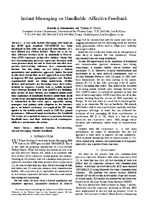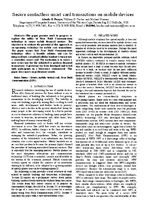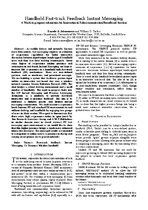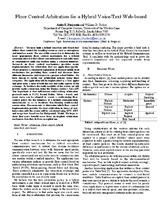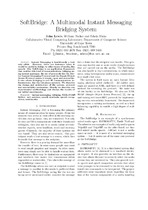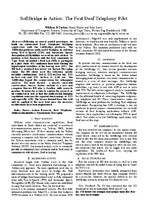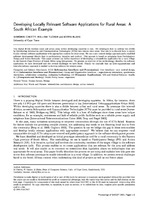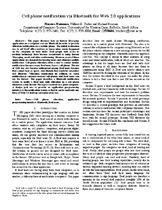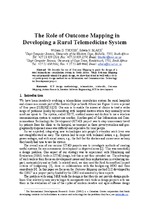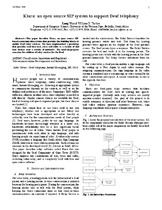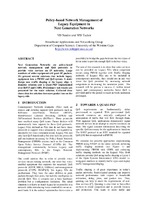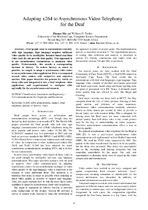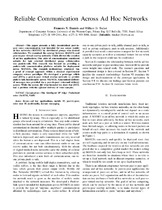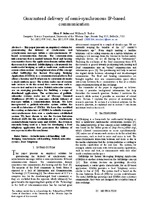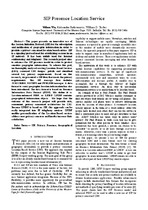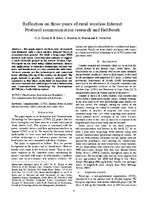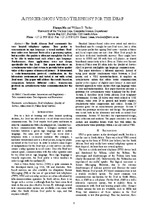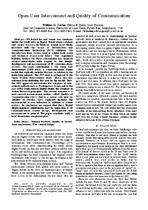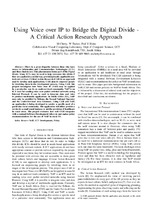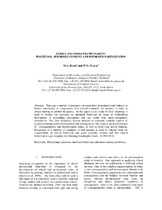Researchers in Computer Science: Recent submissions
Now showing items 61-80 of 89
-
Instant Messaging on handhelds: affective feedback
(Telkom, 2004)A text only Instant Messaging (IM) built on the IETF open standard SIP/SIMPLE has been developed in line with our proposed introduction of a user-defined text Hotkey feature. These act as an on-click Affective Gesture (AG): ... -
Secure contactless smart card transactions on mobile devices
(Telkom, 2009)This paper presents work in progress to explore the utility of Near Field Communication technology to secure mobile financial services. The objective is to evaluate the potential of this approach as an upcoming technology ... -
Handheld fast-track feedback instant messaging
(Telkom, 2003)As mobile devices and networks become more data-centric, text messaging requires an extension of co-presence capabilities for better interactive discussion between input/output handicapped handheld users and their free ... -
Floor control arbitration for a hybrid voice/text web-board
(Telkom, 2003)We have built a hybrid voice/text web–board that utilizes floor control for handling resources such as microphone and interface events. The aim of this research is to determine the most appropriate floor control mechanism ... -
SoftBridge: a multimodal instant messaging bridging system
(Telkom, 2003)Instant Messaging is traditionally a text only a air. However, there are instances when it would be useful to bridge to other types of media, like speech. The SoftBridge is an application framework that enables this kind ... -
SoftBridge in action: the first Deaf telephony pilot
(Telkom, 2003)Following on several partial prototypes, we built an automated Deaf Telephony bridging application with the SoftBridge platform. The SoftBridge performs multi-modal bridging in real-time using Text-to-Speech (TTS) and ... -
Developing locally relevant applications for rural areas: a South African example
(SAICSIT, in assocation with ACM, 2004)The digital divide between rural and urban areas within developing countries is vast. We investigate how to address this divide by introducing Information and Communication Technologies (ICTs) into remote rural areas. Our ... -
Cell phone notification via bluetooth for Web 2.0 applications
(Telkom, 2009)This paper discusses how an Instant Messaging application on a computer can use Bluetooth in order to provide vibration notification on a mobile phone. The initial motivation was to aid Deaf1 office workers to know when ... -
The role of Outcome Mapping in developing a rural telemedicine system
(International Information Management Corporation, 2008)We describe the use of Outcome Mapping to guide the design of a rural telemedicine consultation system in South Africa. While Outcome Mapping was not primarily intended to guide design, we show that it tied in well with a ... -
Kiara: an open source SIP system to support Deaf telephony
(Telkom, 2008)This paper describes Kiara, an open source SIPbased communication system that provides the building blocks to enable Deaf relay services. We have implemented a prototype that provides real-time text, voice and video to a ... -
Policy-based network management of legacy equipment in Next Generation Networks
(Telkom, 2001)Next Generation Networks use policy-based network management and QoS protocols to provide voice services on IP networks. Large numbers of older equipment still push IP packets. We present several solutions that include ... -
Adapting x264 to asynchronous video telephony for the Deaf
(Telkom, 2008)Deaf people want to communicate remotely with sign language. Sign language requires sufficient video quality to be intelligible. Internet-based real-time video tools do not provide that quality. Our approach is to use ... -
Reliable communication across ad hoc networks
(Telkom, 2008)This paper presents a fully decentralised peer-topeer voice communication tool intended for use across mobile ad hoc networks (MANET) by distributed groups who desired collaboration. We examined the synergy between MANETs ... -
Guaranteed delivery of semi-synchronous IP-based communication
(Telkom, 2005)This paper presents an empirical solution for guaranteeing the delivery of synchronous and asynchronous messages within a semi-synchronous IPbased communication domain. The communication infrastructure that is needed between ... -
SIP presence location service
(Telkom, 2005)This paper presents an innovative use of the Session Initiation Protocol (SIP) for the subscription and notification of geographic information in order to provide a privacy concerned location-based service. SIP is a signaling ... -
Reflection on three years of rural wireless Internet Protocol communication
(Telkom, 2007)This paper reports on three years of research and fieldwork with a rural wireless Internet Protocol communication project. We built a long-range WiFi network and custom communication software to support a rural telehealth ... -
Asynchronous video telephony for the Deaf
(Telkom, 2007)The South African Deaf community has very limited telephony options. They prefer to communicate in sign language, a visual medium. Realtime video over Internet Protocol is a promising option, but in reality, the quality ... -
Open user interconnect and quality of communication
(Telkom, 2004)We looked for and found two situations within the South African Digital Divide where constant and severe macro-scale latencies would most likely interfere with the usage of Information and Communication Technology (ICT) ... -
Using voice over IP to bridge the digital divide: a critical action research approach
(Telkom, 2003)There is a great disparity between those who have access to Information and Communication Technologies (ICTs) and those that do not. This phenomenon forms part of the Digital Divide. Many ICTs may be used to help overcome ... -
Ethics and mono-disciplinarity: positivism, informed consent and informed participation
(Elsevier, 2005)There are a number of pressures on researchers in academia and industry to behave unethically or compromise their ethical standards, for instance in order to obtain funding or publish frequently. In this paper a case study ...

